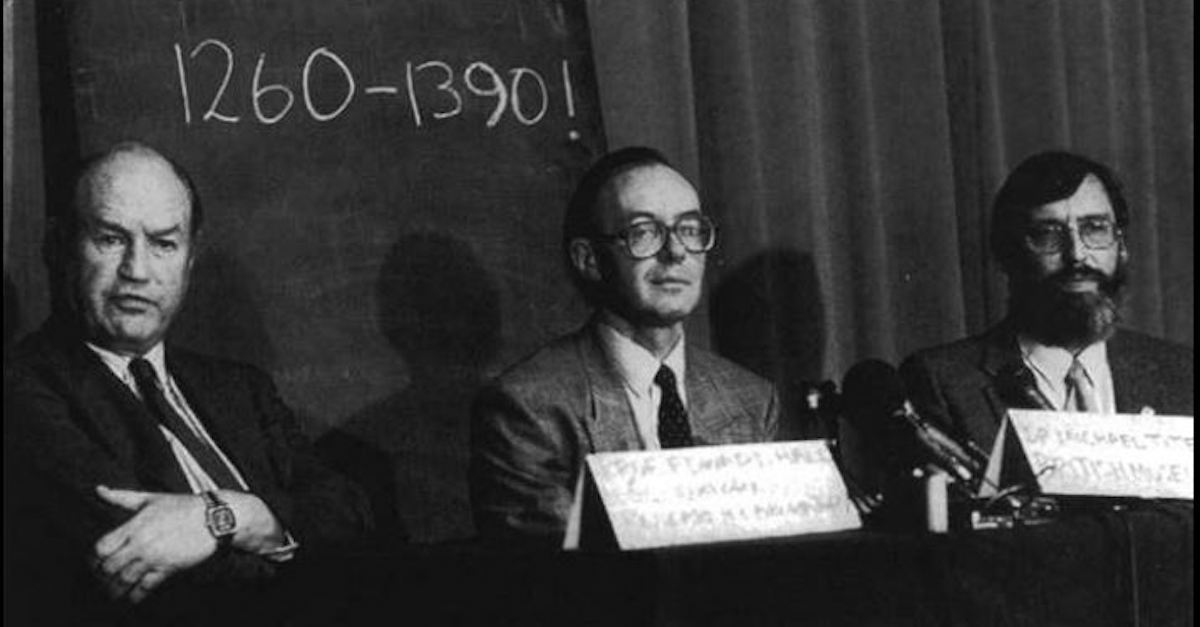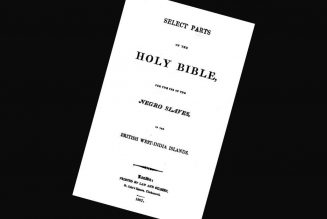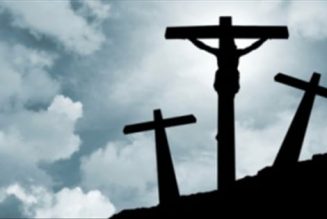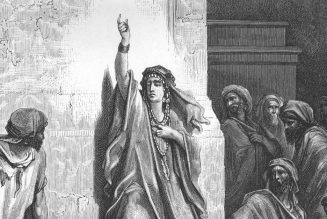Above Photo: The face of the Shroud man as it appears to the naked eye and as a photographic negative ( positive.) Shroud Photographs ©1978 Barrie M. Schwortz Collection, STERA, Inc
The Shroud of Turin is a rectangular linen cloth comprised of flax measuring 14.6 feet long and 3.5 feet wide. It bears a faint yellowed image of a bearded, crucified man with bloodstains that match the wounds suffered by Jesus of Nazareth as recorded in all four gospel narratives. Since 1578 the Shroud has resided in Turin, Italy, thus the name, the Shroud of Turin. The holy relic is housed in the Cathedral of St. John the Baptist. Millions of Christians from all denominations believe that the Shroud is the authentic burial cloth used to wrap Jesus after his death on the cross, and found by his disciples in the empty tomb after his resurrection.
The Shroud’s most distinctive characteristic triggers the most frequently asked and still unanswered overarching question: What “caused” a front to back linear mirror image of an adult male to be formed on a linen burial cloth? The fact that science has yet to produce a definitive answer explains why the Shroud of Turin is the most studied, analyzed, revered, and controversial artifact in the world. Connecting Christ to his purported burial Shroud is a process addressed by the following questions and answers:
What does the Bible say about what happened to Christ’s body immediately after his death on the cross?
Joseph of Arimathea asked Pilate for the body of Jesus (John 19:38).
How was the body of Jesus prepared to be entombed?
The question of whether Joseph of Arimathea wrapped Christ in “strips of linen” or “linen cloths” is an important point of contention for those who contest the Shroud’s authenticity. Depending on the Bible translation, the words “strips of cloth”- “cloths” – “cloth” are all used, contributing to the controversy. Many researchers think that strips were used to bind the chin, the wrists, and the feet. Moreover, Joseph of Arimathea would have needed strips of cloth to bind Christ’s body to the 14-foot burial shroud because “Nicodemus brought a mixture of myrrh and aloes, about seventy-five pounds” (John 19:39).
Scripture says: Taking Jesus’ body, the two of them wrapped it, with the spices, in strips of linen. This was in accordance with Jewish burial customs” (John 19:40).
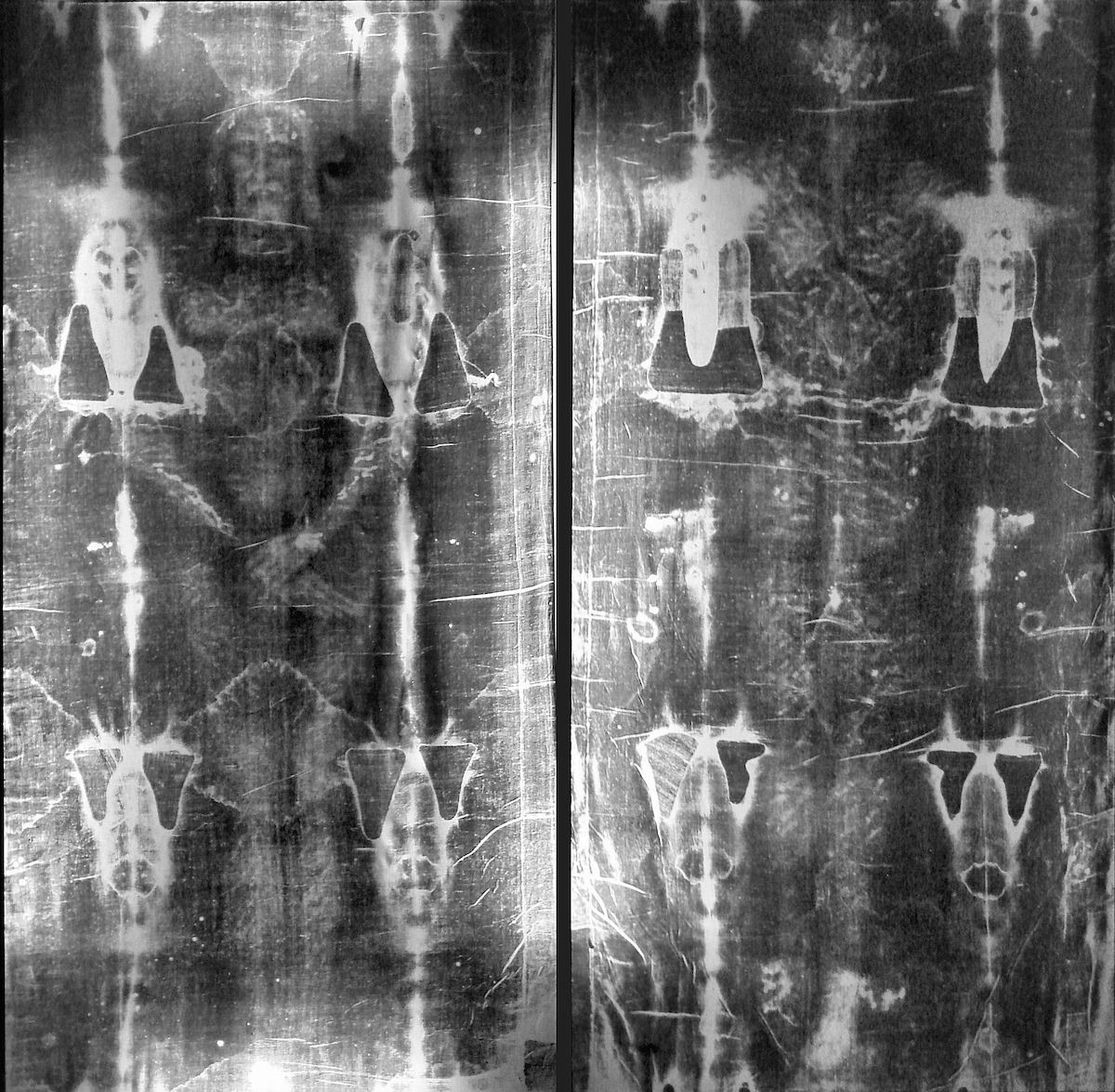
The Shroud of Turin as it appears on a photographic negative (positive). Front and back views with side by side vertical orientation. Shroud Photographs ©1978 Barrie M. Schwortz Collection, STERA, Inc.
When and Where Was the Shroud of Turin Found?
All four gospels state that Joseph owned the cloth used to wrap Jesus before he was entombed. However, only the Gospel of John mentions the apostles finding the burial cloth(s) in the tomb after Christ’s resurrection on that Sunday morning in Jerusalem. The following passage begins the mystery about the Shroud of Turin:
“Then Simon Peter came, following him, and went into the tomb; and he saw the linen cloths lying there, and the handkerchief that had been around His head, not lying with the linen cloths, but folded together in a place by itself” (John 20:6-7).
It is reasonable to assume that the twice mentioned “linen cloths” (along with the words “strips” or “wrappings” in some translations) describe what is now called the Shroud of Turin. But what then is the “handkerchief that had been around His head.”? The “handkerchief” or “napkin” (in some translations) is thought to be what is named the “Sudarium of Oviedo.”
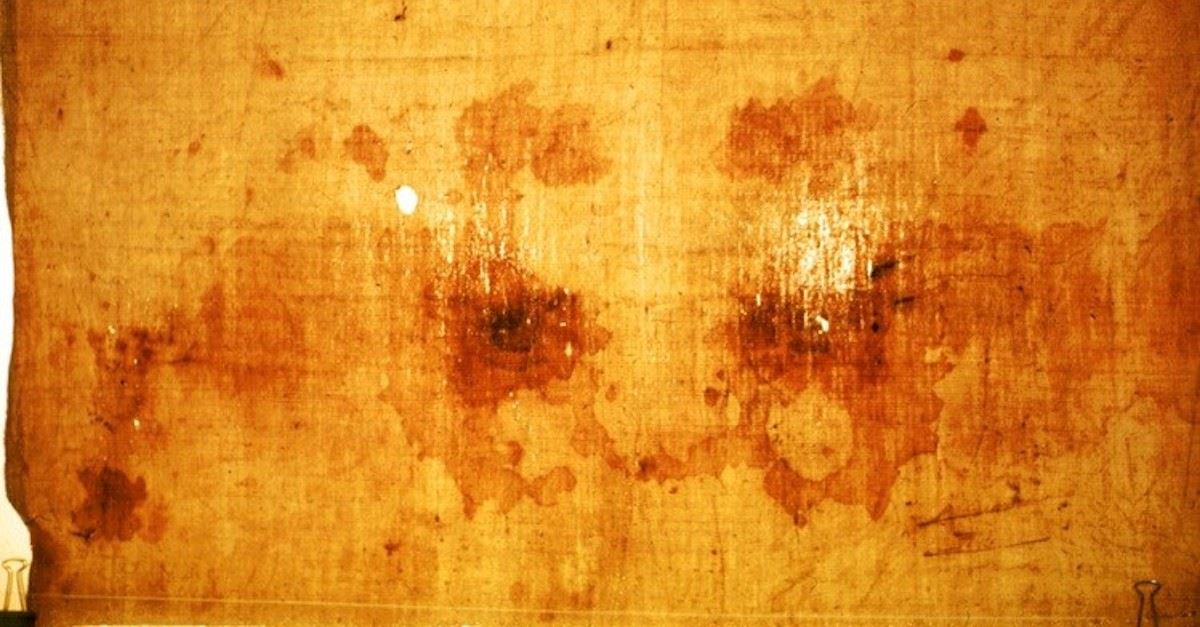
Sudarium of Oviedo: The “handkerchief” or “napkin” thought to have covered the face of Jesus. Shroud Photographs ©1978 Barrie M. Schwortz Collection, STERA, Inc.
What Is the Sudarium of Oviedo and How Is it Connected to the Shroud?
The Sudarium is another revered, yet controversial cloth residing in the Cathedral of Oviedo, Spain. Similar to the Shroud, evidence suggests the Sudarium —a smaller piece of linen measuring 34 by 21 inches —touched Jesus after his death. According to the aforementioned Gospel of John, this cloth was “around his head.” Speculation is that out of respect for the dead, the cloth was placed on the face of Jesus immediately after the crucifixion before he was wrapped in his burial Shroud.
The key difference between the Sudarium and the Shroud is that the former does not display a man’s image. Nonetheless, the “handkerchief” is stained with blood, and other human secretions of suffering that recent scientific studies have determined are a perfect forensic match to the face wounds found on the Man of the Shroud. The Sudarium is often called the “companion” to the Shroud and thought by scientists to authenticate the Shroud because of the bloodstains on both cloths test as the rare Type AB.
Timeline of the Shroud’s Mysterious and Scientific Properties
Scientific and technological breakthroughs —starting in the 19th century with the advent of photography and into the 20th century — led to startling discoveries revealing that the Shroud possessed unexplained properties. We can also surmise that as technology advances, more “unexplainable” properties will be discovered, and the Shroud will continue to baffle scientists well into the future.
1898: The Shroud was photographed for the first time by an Italian named Secondo Pia. His pictures led to a startling discovery: The cloth’s faint yellowed image of a man, as seen with the naked eye, is actually a negative image that, when developed, turns into a detailed black and white positive. Pia’s unexplainable discovery startled him, along with Church authorities and the scientific community. It also stimulated worldwide interest in the Shroud. The modern era of Shroud science had begun.
1931: Thirty-three years, later given the advancement of photography, Guisseppe Enrie was commissioned by the Church to photograph the Shroud for a second time. Enrie confirmed Pia’s finding that the Shroud is a negative image that develops as a positive. (Pia, still alive, was vindicated after his photos had been questioned by Church authorities.) Copies of Enrie’s photos were circulated throughout the world. His prints prompted more scientific inquiry and increased general interest in the mysterious cloth with the unforgettable face of a deceased, crucified man.
1950: “A Doctor at Calvary” was published by Dr. Pierre Barbet, a prominent French surgeon. His book documented 15 years of medical research on the Shroud image, often in gruesome detail. Dr. Barbet described the physiology and pathology of the crucified man on the Shroud as “anatomically perfect.”
1973: Max Frei, a noted Swiss criminologist, was given permission to take dust samples from the Shroud that contained numerous pollen spores. He discovered 22 pollen species from plants unique to areas around Constantinople and Edessa, (where the Shroud was thought to have traveled after leaving Jerusalem) as well as seven pollen species from plants common only in Israel. The pollen trail appears to corroborate the historic trail.
1975: Air Force scientists John Jackson and Eric Jumper, using a VP-8 Image Analyzer designed for the space program, discovered the Shroud image contained encoded 3-D data not found in ordinary reflected light photographs. Their discovery indicated that the cloth contained “distance information” and must have wrapped a real human figure at the time the image was formed. (In 2010 the History Channel first aired what was to become a popular, long-running documentary, “Real Face of Jesus?” The film interfaced the Shroud’s 3-D data, first found in 1975, with 21st-century computer graphics to construct the “real” face of the man depicted on the Shroud.)
1978: The Shroud was on public exhibit for six weeks for the first time since 1933. At the close of the exhibition, nearly 30 scientists (headed by John Jackson and Eric Jumper) comprised the Shroud of Turin Research Project known as STURP. The scientists, representing numerous areas of expertise, analyzed the Shroud for five continuous days using state-of-the-art technology at the time.
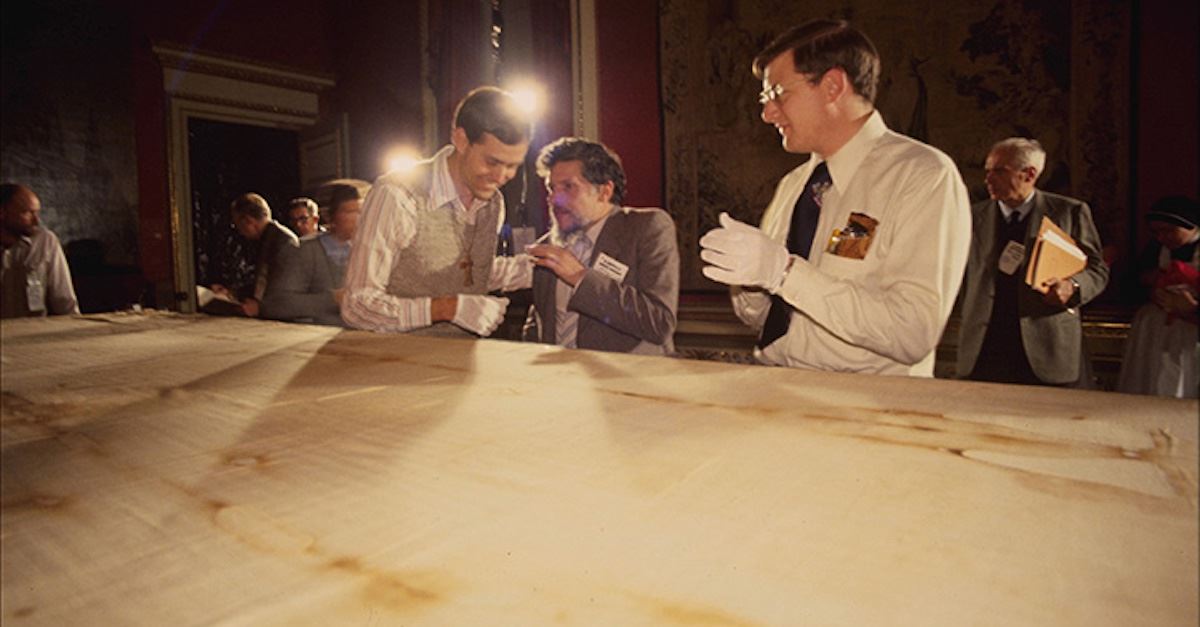
John Jackson, Prof. Luigi Gonella and Eric Jumper prepare to begin the examination of the Shroud of Turin in 1978. Shroud Photographs ©1978 Barrie M. Schwortz Collection, STERA, Inc
1980: National Geographic magazine published a landmark article on the Shroud. Utilizing STURP photography, National Geographic propelled the cloth into the science and mainstream limelight after calling the Shroud, “One of the most perplexing enigmas of modern times.”
1981: After three years of analyzing the scientific data collected in 1978, the STURP scientists’ publicly shared their findings at an international conference in New London, CT. All the scientists agreed to the concluding statement: “Thus, the answer to the question of how the image was produced or what produced the image remains, now, as it has in the past, a mystery.” The final paragraph of STURP’s written reported read:
“We can conclude for now that the Shroud image is that of a real human form of a scourged, crucified man. It is not the product of an artist. The bloodstains are composed of hemoglobin and also give a positive test for serum albumin. The image is an ongoing mystery, and until further chemical studies are made, perhaps by this group of scientists, or perhaps by some scientists in the future, the problem remains unsolved.”
1988: STURP’s conclusions led to an interest in the date of the cloth, and the Vatican authorized testing. A small corner of the Shroud was cut and radiocarbon dated (C-14) by three laboratories in Oxford, Zurich, and Arizona. The labs determined a date range from between 1260 to 1390. This earth-shattering news contradicted STURP’s conclusions that supported the Shroud’s possible authenticity.
Additionally, the C-14 test results shocked the global Shroud scientific community who, in general, from day one, was highly suspicious of the medieval date due to the test’s questionable protocols. It is these extremely controversial 1260 to 1390 dates that birthed the phrase; the “Shroud is medieval hoax,” which negatively impacted and denigrated the Shroud for decades. (Keep reading for important 2005 and 2019 updates about the raw data used in the 1988 test.)
Press conference British Museum, on Oct. 13, 1988 announcing the 1260 -1390 Shroud dating, shocking the world and the Shroud scientific community. Photo is public domain.
1997: Avinoam Danin was a prominent Israeli Botanist and professor at Hebrew University in Jerusalem. He confirmed the presence of flower images on the Shroud verifying 28 different pollen species and plant images — many that grow only around Jerusalem. Danin famously wrote, “March-April is the time of year when the whole assemblage of some 10 of the plants identified on the Shroud is in bloom.” Danin’s book, “Botany of the Shroud,” was published in 2010.
2004: Textile expert Mechthild Flury-Lemberg revealed that the stitching of a seam on the Shroud that runs the entire length, known as the “side-strip,” is typical of Jewish burial shrouds found in the ancient fortress of Masada in southern Israel. She verifies the Shroud as a style of textile used in First Century Israel.
2005: Raymond Rogers was Director of Chemical Research for STURP. He was a renowned American thermal chemist who, for over three decades, worked at the prestigious Los Alamos National Laboratory. Rogers obtained thread samples from the same outer corner of the Shroud that in 1988 was C-14 tested — along with thread samples from the interior of the Shroud. After conducting additional micro-chemical and spectroscopic tests, he proved that the samples were not the same.
The key to Roger’s finding was that the area cut for C-14 dating appears to be from a medieval reweave instead of the original Shroud. Rogers study concluded: “The radiocarbon sample was not part of the original cloth of the Shroud of Turin. The radiocarbon date was thus not valid for determining the true age of the shroud.”
Rogers’s results, published in a peer-reviewed journal, confirmed the concerns of the Shroud’s scientific community, and in 2004 he answered the most frequently asked questions about his study. Rogers’ breakthrough study provided the answers as to why the 1988 C-14 test results were so suspect. It turned out that the C-14 test labs violated the original sampling protocol established in 1985. Three different samples were to be cut; instead, only one sample was used. Ignoring caution from archaeologists, the test administrators cut the test sample from the most handled area of the cloth — the outside corner edge. That area is exactly where, for centuries, the Shroud had been held and handled by royalty and Church authorities for public celebrations and exhibitions. Therefore, the Shroud cloth sample tested was cut from the area with the most potential for contamination, damage, and, as Rogers believes, may have been repaired.
2011: European researchers with the Italian ENEA (National Agency for New Technologies) replicated the depth and coloration of the Shroud image using a 40 nanosecond burst from a UV excimer laser. This test is the first time any aspect of the image has been reproduced using light. An ENEA News report dated Dec.21, 2011, was headlined: “Scientists Suggest Turin Shroud Authentic.” The opening paragraph read:
“A team of researchers from the National Agency for New Technologies, Energy and Sustainable Economic Development (ENEA), Italy, has found that the Shroud of Turin is not a fake and the body image was formed by a sort of electromagnetic source of energy.”
2013: Researchers with Padua University in Italy obtained a dozen samples from other linens of a known age ranging from the current era to 3000 BC. They were able to develop a predictable rate of chemical and mechanical decay. By comparing fibers from the Shroud, they determine an estimated date range of 280 BC to 220 AD that includes the First Century. The test results are widely reported throughout the world in the secular media.
2014: The linen decay research continues to be peer-reviewed and a leading member of the Padua University research team, Professor Giulio Fanti publishes a book, “Turin Shroud: First Century A.D.” According to the book’s press release, “The new dating methods are published in prestigious international journals, and no one has yet pointed out methodological errors.”
2015: A respected Shroud researcher and author Mark Antonacci writes a breakthrough book: “Test the Shroud: At the Atomic and Molecular Levels.” Antonacci proposes that a new series of sophisticated, minimally-invasive tests be performed on the Shroud at the atomic and molecular levels. His hypothesis is published in a peer-reviewed scientific journal, and although it involves a miraculous event consistent with the resurrection, its occurrence can be scientifically tested. Antonacci asserts that these proposed tests could prove whether the Shroud was irradiated with particle radiation; whether the source was the length, width, and depth of the crucified corpse in the cloth; when this event happened; where it occurred; the age of the Shroud and its blood; and the identity of the victim. Antonacci brings his testing request to the Vatican.
2018: The results of “blood flow tests” make headlines around the world: “New Forensic Tests Suggest Shroud of Turin is Fake.” The tests, using blood on mannequins and volunteers, determine that the blood flows, as seen on the Shroud, differed from their tests. These led to the conclusion that the Shroud is fake. The tests are highly criticized by numerous, distinguished members of the Shroud’s scientific and scholarly community. The conclusions also contradict STURP’s findings and that of several forensic pathologists. The wide mainstream news coverage of the test results is out of proportion to the methodology and validity of the study. The coverage also does not detail the known bias of the group who conducted the study.
2019: The 1988 radiocarbon test (C-14) concluding that the Shroud dated between 1260 -1390 is subjected to new scrutiny. The controversial results of the C-14 tests published in the prestigious scientific journal “Nature” in 1989, did not publish all the data because it was not provided by the British Museum. And, for 30 years, Shroud scientists had accused the museum of hiding the raw data.
In 2017 French researcher, Tristan Casabianca filed a legal action against the British Museum, which oversaw the C-14 testing labs in 1988. The museum complied and finally releases all the raw data. Casabianca’s research team ran new tests and conclude in their 2019 report that there were numerous dates that fell outside the range published in “Nature.” They prove that the Shroud cloth sample is not homogenous, and the 1988 results, famously reported with “95% confidence” are suspect. Casabianca’s team supports the widely-held belief that something went awry with the C-14 tests, which for the ensuing decades discouraged Shroud research and disparaged the Shroud as a medieval fake. Casabianca and his team are advocating that the Vatican authorize a variety of new 21st-century testing methods not available in 1988 or 1978 during STURP’s testing.
Science Cannot Explain the Shroud’s Mysterious Characteristics and Properties
The Shroud is fascinating to scientists, the religious community, and the general public because of the numerous mysteries contained on, in, or NOT on, in, the cloth. All the cloth’s unexplained mysteries point to two overarching questions:
– Is the Shroud the authentic burial cloth that wrapped Jesus?
– Is the Shroud proof of Christ’s resurrection?
Four decades ago, for the first and only time, King Umberto II (then owner of the Shroud) authorized comprehensive testing providing STURP (Shroud of Turin Research Project) with hands-on access to the cloth. Today, STURP’s 1978 findings still stand as the primary scientific source cataloging the Shroud’s unique properties.
Below is a partial list found by STURP’s team of over 30 distinguished scientists:
- No substances manually applied to the cloth.
- No artistic substances such as paint, ink, dye, pigments, or stain were used to constitute the image.
- No collagen binder as would be used with paint
- No fibers cemented to each other as with paint.
- No capillary action — meaning no liquids were applied to form the image.
- No substances found between threads, as with a dust rubbing.
- Bloodstains on cloth test positive for heme, bile, serum albumin, and other human blood components. The blood is male type AB.
“The blood marks seen on the shroud are consistent with a contact transfer to the cloth of blood clot exudates that would have resulted from major wounds inflicted on a man who died in the position of crucifixion.” Dr. Al Adler—Blood chemist STURP Team
The following are image characteristics found on or about the Shroud:
– The image is purely superficial. It does not penetrate the cloth – only rests on the top two micro-fibers. (Analogous to the Shroud image resting on the hairs of your forearm.)
– The image is a photographic negative that develops as a positive.
– The image contains 3D “distance information” similar to a topographical map.
– No directionality to the image, as found with a brush or any substance application tool.
– No variation in the depth of the image. (Virtually impossible with human hands.)
– The yellowing of the image is uniform in intensity.
– No outline or defined edges to the image.
STURP conclusion: “There are no chemical or physical methods known which can account for the totality of the image, nor can any combination of physical, chemical, biological, or medical circumstances explain the image adequately.”
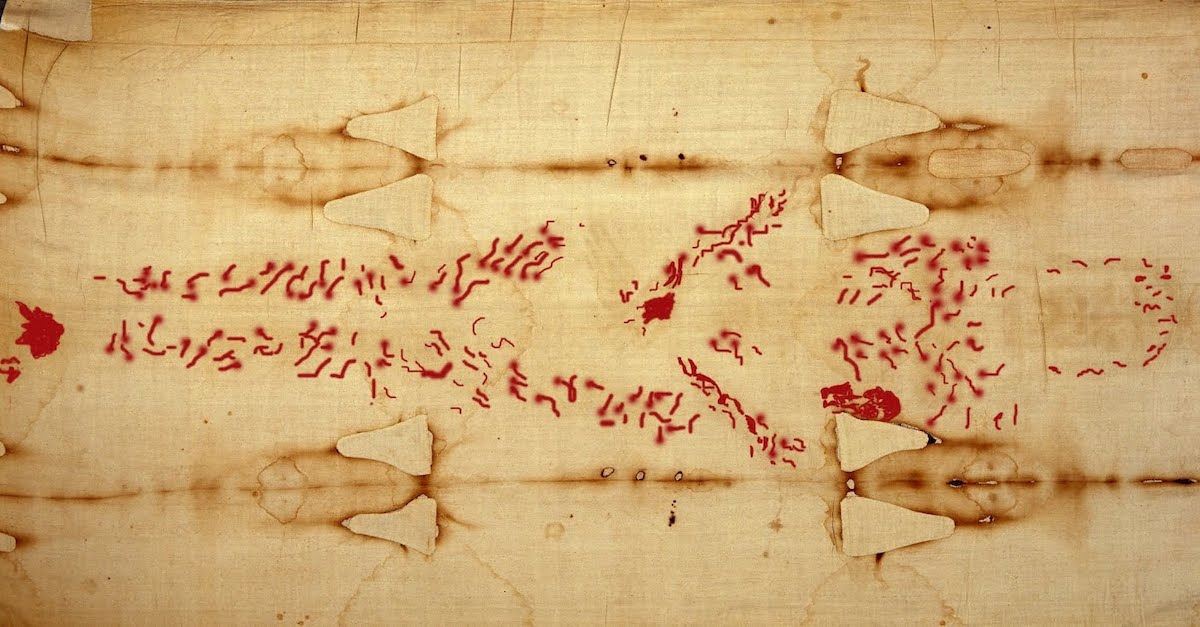
Front image of Shroud Man with blood marks highlighted. Shroud Photographs ©1978 Barrie M. Schwortz Collection, STERA, Inc
Are the Marks on the Man of the Shroud Compatible with the Gospel Accounts of Christ’s Suffering?
Medical forensics determined by STURP concluded that the cloth wrapped a human corpse. Blood chemistry indicates human blood from actual wounds. Botanical studies concluded that the cloth originated in Israel. Alternate dating methods (Professor Giulio Fanti, 2013-14) include the First Century within the range. However, can it be proved that the image of “the Man of the Shroud” is Jesus Christ? Only by inference according to the four gospels:
– Bloodstains on the head compatible with a crown of thorns.
– Over 120 scourge (whip) marks compatible with Roman flagrum.
– Nail wound in the wrists (more anatomically correct to hold the weight of the body than the palm of the hand)
– Nail wound in the feet. (The man’s feet were on top of each other.)
– Legs are pulled up due to rigor mortis. (A stiffness of muscles that sets in quickly after death and lasts less than four days.)
– Blood is sourced from actual wounds showing evidence of gravity from a vertical position. (On the cross?)
– No stains of body decomposition. (Resurrection happened on the third day before decomposition had time to occur?)
– Wound in the side compatible in size with a Roman spear tip.
– Post-mortem blood flow from the side wound that also flows across the back.
– Legs of the man were not broken. (Old Testament prophecy fulfilled)
The last three points are interconnected and worthy of explanation. Unique to Jesus was that he was horrifically scourged before he was crucified. As stated in the Apostles Creed: “He suffered under Pontius Pilate, was crucified, died, and was buried.” Pontius Pilate thought that if he had Jesus brutally scourged — then brought him before the Jewish High Priests and the crowd — that they would not also demand his crucifixion.
By Roman design, crucifixion was a long torturous process ending in asphyxiation. But Jesus so weakened by his pre-crucifixion ordeal, died faster than the two thieves beside him. With the Sabbath hour fast approaching, the Jewish authorities demanded that all three bodies be taken down from their crosses. However, the two thieves were still alive when the order was given to break their legs — making them unable to push their bodies up to breathe.
But, Jesus had already died, so his legs were left intact — compatible with the legs of the Shroud man — fulfilling the previously mentioned Old Testament prophesy. And to confirm Jesus’ death, the Romans pierced his side with a spear— another unique characteristic seen on the Man of the Shroud as recorded in John 19:34. Except for Jesus, there is no man in recorded Roman history who was severely scourged and crucified. Normally, it was one punishment or the other. The Man of the Shroud endured both as written in the gospels.
Shroud History Timeline
The most important fact to know about the history of the Shroud is that there are two timelines: The first is before 1356 —based on circumstantial evidence, legend, art, and coins. The second is after 1356,when the Shroud’s trail is documented and accepted by historians.
A Reconstruction of the Shroud’s Trail Before 1356:
Early First Century – Jerusalem was destroyed by the Roman Empire. Legend and folklore speak of a mysterious cloth with healing power, bearing an image of Jesus that arrived in Edessa (now Urfa, Turkey) circa First Century AD. The Apostle Jude Thaddeus, one of the original Apostles of Jesus Christ, is associated with bringing the cloth from Jerusalem to Edessa.
Early Second Century – Christian persecutions in the Second century were supposedly the reason why the cloth was hidden inside the fortified wall surrounding the city of Edessa.
525 A.D. – After a severe flood destroyed most of Edessa, the cloth was rediscovered when the walls —where the cloth had been hidden for over 400 years —were being rebuilt. The cloth became known as “The Image of Edessa” and later was called “The True Likeness of Christ not made by human hands.” All Orthodox icons of Jesus and Byzantine coins dramatically change to conform to the True Likeness featuring long hair, full beard, large eyes, and flattened nose—all stylistically similar to the Shroud image.
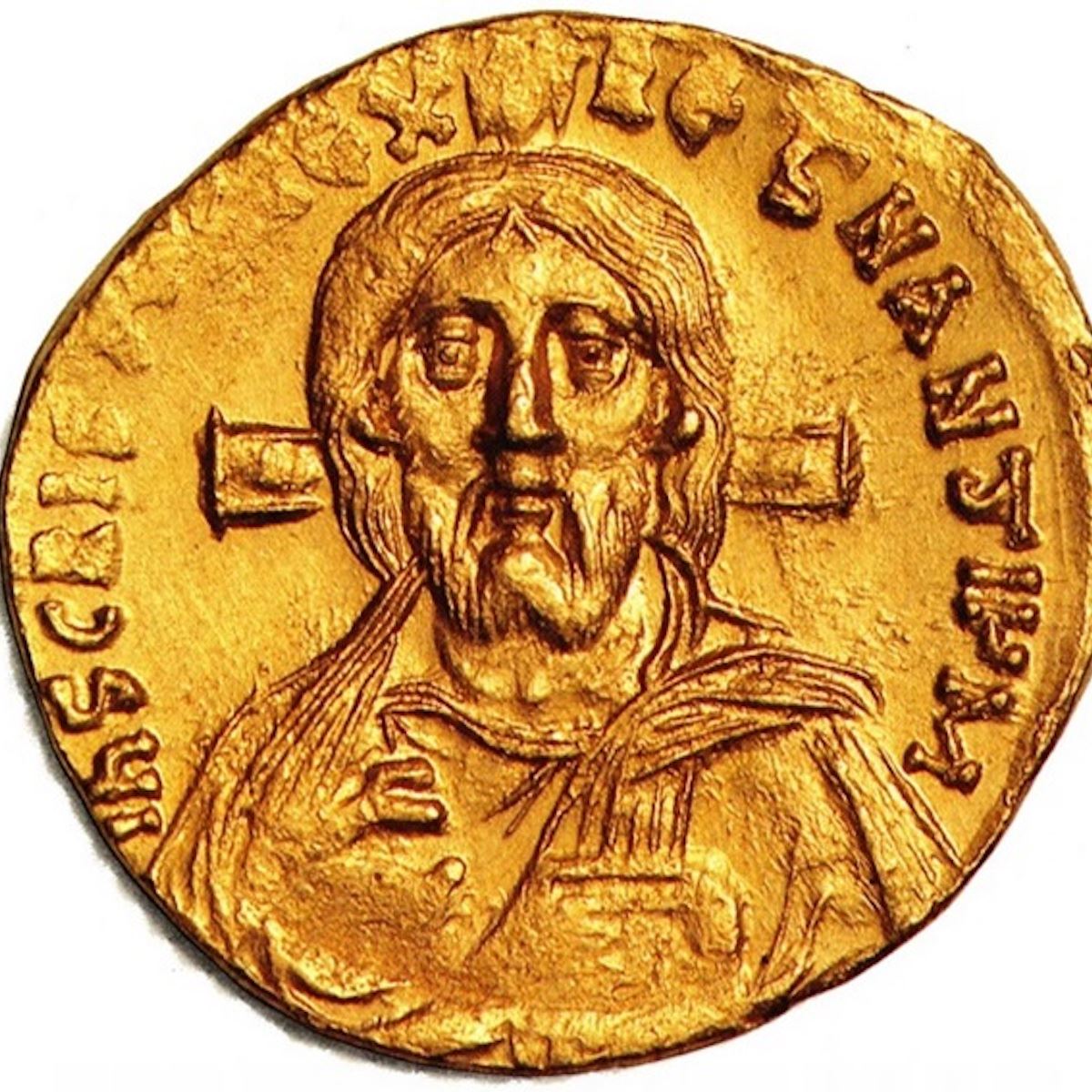
Byzantine era coin dating from AD 692 shows Jesus on a cross bearing a remarkable resemblance to Shroud face.
944 A.D. – The Byzantine Imperial Army invaded Edessa for the express reason of retrieving the cloth from the city which had fallen to Islam. It was taken to Constantinople (now Istanbul) and presented to the Emperor.
1204 A.D.– Constantinople was invaded by the Fourth Crusade, and the revered cloth disappeared. Some historians believe, and 2009 Vatican research supports long-time rumors that the Shroud was held in secret possession by the Knights Templar before 1356 when the cloth was displayed in France.
Note: There is a significant piece of physical evidence that a burial cloth with an image resembling the man depicted on the Shroud was in Constantinople prior to 1204 A.D. (Before supposedly being stolen by the French during the Fourth Crusade.) This “proof” is known as the Pray Codex or Hungarian Pray Manuscript, a collection of medieval manuscripts with imagesdated to the late 12th to early 13th centuries.
The Codex resides today in the National Széchényi Library of Budapest.
Documented History Begins
1356 A.D. – Geoffrey DeCharney first exhibited the Shroud in Lirey, France. Evidence indicates that members of DeChaney’s ancestral family were also leaders within the Knights Templar organization. For a detailed history of the Shroud by century, visit the full history page on Shroud.com.
Highlights of the Shroud’s Documented History That Today Impacts the Shroud of Turin:
December 4, 1532: The Shroud is folded in 48 layers inside a silver reliquary in Sainte Chapelle, Chambéry, France. A fire breaks out, and drops of molten silver burn through the cloth’s outer folded edges. Miraculously the entire cloth was not destroyed, but the burning silver drops left those distinctive linear markings that line both sides of the Shroud image that we see today. Here are first-hand accounts of the fire from a report of the Chambery nuns dated 1534.
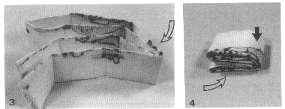
The folding of the Shroud in its casket — This model shows the results of the fire of Dec. 4, 1532 Credit: Professor Jerome Lejeune
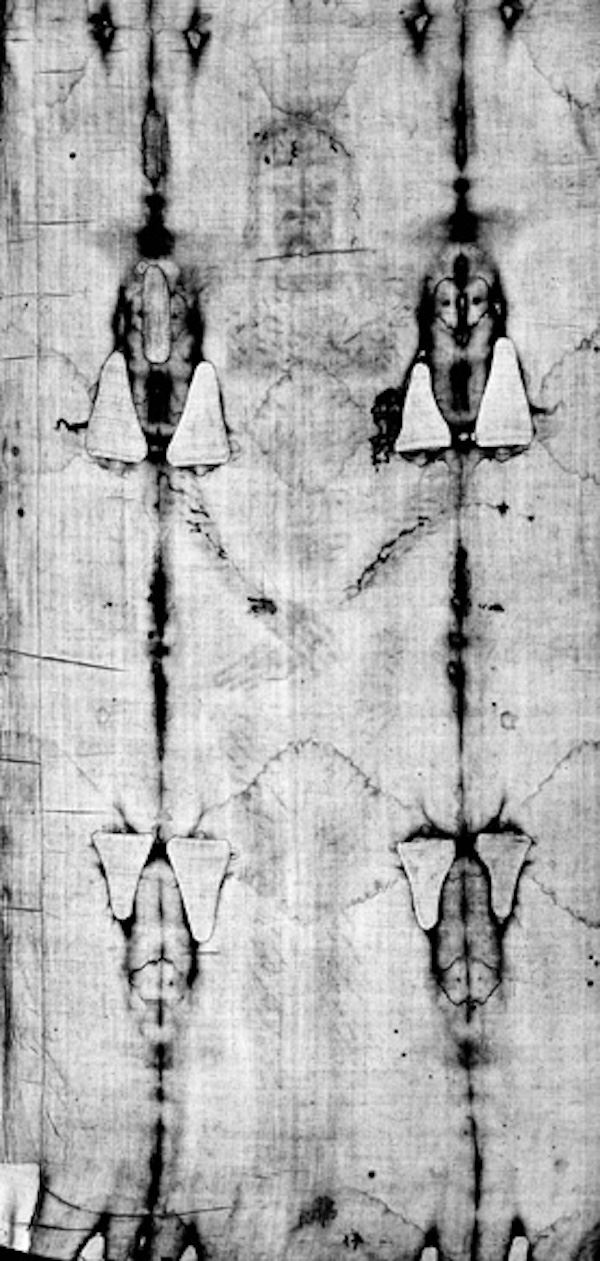
The burns left from the 1532 fire as seen on a vertical contrasted black and white image. Shroud Photographs ©1978 Barrie M. Schwortz Collection, STERA, Inc.
April 16, 1534: Chambéry’s nuns repair the Shroud’s fire damage. The nuns sew the Shroud to a backing cloth and sew patches over the most unsightly damaged areas. With repairs completed in May 1534, the Shroud is returned to the Savoys’ castle in Chambéry, France, owners of the Shroud.
Note: The royal Savoy family owned the Shroud from 1450 to 1982 until the former King of Italy, Humberto II passed away and willed the Shroud to the current living Pope.
September 14, 1578: The Shroud arrives in Turin, heralded by a gun salute from the local artillery. The cloth has remained since that time and why it is called the Shroud of Turin.
Second World War 1939 – 1946: On April 8, 2010, the day before the Shroud was going on rare public display, it was revealed and widely reported that in 1939, the Shroud was secretly moved from Turin to Montevergine Abbey in southern Italy. Reportedly, the Shroud needed to be hidden from Hitler. It remained there until 1946 when the Shroud was quietly returned to Turin. Documents found at the Abbey confirmed that the Shroud was “hidden under the altar of a small chapel” with only a select number of authorities knowing that the Shroud had even been moved from Turin.
April 11-12 1997: A destructive fire breaks out in Turin’s Guarini Chapel, quickly threatening the Shroud housed in a bulletproof display case. Fireman Mario Trematore uses a sledgehammer to break open the case and rescue the Shroud. Later, arson is determined to be the cause, but the Shroud is found to be unaffected by the fire.
April 19 – June 24, 2015: The Shroud’s last public display. A history of the most recent Shroud public exhibitions, starting in 1898, is found here.
2025: Next Shroud public exhibition? Shroud exhibition dates are set by the Pope. There is speculation that the next one will be in 2025. Watch this “official” Holy Shroud site for confirmation and tickets. (Google will translate this Italian site into English.)
What Is the Catholic Church’s Official Position on the Shroud of Turin?
Author Myra Adams posed this question to Catholic priest, Father Andrew Dalton, an international Shroud expert and speaker with the Legionaries of Christ. Dalton is also an Assistant Professor of Theology at the Pontifical Athenaeum Regina Apostolorum in Rome, Italy.Dalton replied: “The official opinion of the Catholic Church is that she does not have an official opinion. Since there is no dogma regarding the Shroud, Catholics are free to accept or reject its authenticity.”
Dalton continued: “That said, one cannot fail to notice the consistent veneration of the Shroud in the Catholic Church down through the ages. Today, the sacred linen is housed in the side altar of Turin’s cathedral, where it is covered by a beautiful cloth. An embroidered expression reads in Latin, “TUAM SINDONEM VENERAMUR, DOMINE, ET TUAM RECOLIMUS PASSIONEM,” which means, “We venerate your Shroud, O Lord, and we meditate upon your Passion.” All the recent Popes have spoken publicly about this veneration. Nevertheless, Catholics are ever aware that our veneration terminates, not in the cloth itself, but in the divine Person of Jesus Christ, to which it directs us.”
It must also be noted that the Catholic Church has never declared the Shroud to be the authentic burial Shroud of Jesus. Divergent statements from the current, recent, and past Popes about the Shroud of Turin seem to support what Father Dalton described as a lack of “official opinion.” For example, here is an excerpt from the remarks given by Pope John Paul II when he visited the Shroud at St. John the BaptistCathedral in Turin, Italy on Sunday, May 24, 1998:
“The mysterious fascination of the Shroud forces questions to be raised about the sacred Linen and the historical life of Jesus. Since it is not a matter of faith, the Church has no specific competence to pronounce on these questions. She entrusts to scientists the task of continuing to investigate, so that satisfactory answers may be found to the questions connected with this Sheet, which, according to tradition, wrapped the body of our Redeemer after he had been taken down from the cross.”
Pope Benedict, when he visited the Shroud on public display in May 2010, called the Shroud an “icon,” saying that the cloth, “wrapped the remains of a crucified man in full correspondence with what the Gospels tell us of Jesus.”
Pope Francis, when paying homage to the Shroud at its last public display in June 2015, said, “The icon of this [Jesus’] love is the shroud that even now, has attracted so many people here to Turin.” During those same remarks, Pope Francis famously connected the Shroud to worldwide suffering and persecution when he said, “The Shroud draws [people] to the tormented face and body of Jesus and, at the same time, directs [people] toward the face of every suffering and unjustly persecuted person.”
The Protestant Perspective on the Shroud
There is not one definitive stance on the Shroud from any Protestant dominations. However, in general, non-Catholic believers in Christ tend to view the Shroud with more skepticism. Is that because the Shroud is owned by the Catholic Church? For more specific reasons, here is a 2016 essay, “Five Reasons Why Some Christians are Shroud Skeptics.” The author, Barrie M. Schwortz, is the founder of Shroud.com. Schwortz was the 1978 STURP team photographer and is a leading, internationally renowned Shroud expert.
Final Thoughts about the Shroud
Whether or not the Shroud is authentic, physical evidence is never needed or necessary for faith in Jesus Christ. However, in my writings, I have associated the Shroud with the proof needed by a modern-day “Doubting Thomas,” the apostle who insisted on seeing Christ’s wounds before he would believe that Christ was resurrected. Here is what we know for sure about the Shroud:
– The DNA of Jesus is not available, so the Shroud can never be 100 percent proven to be his burial cloth. (Although many would argue that the Sudarium of Oviedo provides a blood and stain match.)
– The Shroud is a “living” cloth because, as in the past, new technologies will reveal new mysterious properties contained within the Shroud.
– The Shroud still exists, and we would argue for a divine reason. And by its very existence, proves that the cloth has been “protected” after being hidden in a wall in Edessa for over 400 years and then surviving through crusades, wars, numerous fires, and even Hitler.
In the end, science cannot render a clear verdict, and the Shroud remains the world’s greatest unsolved mystery.
“The Shroud is either the most awesome and instructive relic of Christ in existence, or it is one of the most ingenious, most unbelievably clever products of the human mind and hand on record. It is either one or the other; there is no middle ground.”—Historian John Walsh
Myra Adams is a media producer and a conservative political and religious writer with numerous national credits. She is also founder and Executive Director of SignFromGod.org, a ministry that evangelizes the Shroud of Turin. Myra and the SignFromGod board members are acting as principal advisers to the Museum of the Bible in Washington, D.C., for their groundbreaking exhibition about the Shroud targeted for February 2021.
To promote the future Shroud exhibition, on January 18, 2020, the Museum is sponsoring an all-star Shroud speaker’s event, Shroud of Turin: Explore the Mystery. Co-writer Russ Breault is hosting and moderating the panel discussions, and two Shroud experts mentioned in this piece, Father Andrew Dalton and Tristan Casabianca are featured speakers. Register here.
Russ Breault has been researching and lecturing on the Shroud for over 30 years and has appeared in numerous documentaries, including Mysteries of the Ancient World on CBS, The Real Face of Jesus on History Channel, and The Holy Winding Sheet on EWTN and was an adviser for Finding Jesus on CNN. He has been interviewed for Good Morning America and ABC’s World News Tonight and has lectured at some of the nation’s leading universities, including Duke, Johns Hopkins, Penn State, and many more. His highly acclaimed comprehensive presentation known as Shroud Encounter has been seen by thousands. He is President of the Shroud of Turin Education Project, Inc. and is on the board of directors of SignFromGod.org. His primary website is www.ShroudEncounter.com
For more information or questions about the event, exhibition any of the content contained within the body of the piece contact, [email protected]

